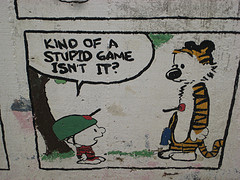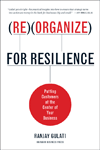|
|
|
Monday, January 19th, 2015

Who do you channel? Sun Tzu or Lao Tzo?
I’ve cited Lao Tzu multiple times over the years, but, unlike most management gurus, not Sun Tzu’s Art of War.
I never liked battle analogies; never understood the idea of “killing the competition.” In spite of what I was told was my naiveté, it seemed to me that loving the customer was more important.
While those battle terms are still around, it seems like I was on to something way back then.
According to Frank Cespedes, Senior Lecturer at Harvard Business School and author of Aligning Strategy and Sales those fighting words get the focus wrong.
Strategy gurus constantly use analogies with battle plans for “competitive advantage” versus the enemy. But the metaphor is not suitable because business, unlike a war or battle, is not primarily about defeating an enemy. Business is primarily about customer value: targeting customer groups and tailoring products, sales and other activities to serve those groups better or differently than others. (…) Peter Drucker emphasized, “The purpose of a business is to create a customer.” That’s also the purpose of any business strategy: make customers, not war.
Winning customers is actually pretty simple, delight them, amaze them and provide them with something they either need or want.
Do all that and the competition will fade away in the eyes of your customers.
And theirs are the only eyes that matter.
Image credit: Kevin Wong
Posted in Communication | No Comments »
Monday, July 14th, 2014
How much can you learn from this video beyond the obvious?
The obvious lesson is that texting while driving can get you killed.
But there are more general take-aways that you can use in any business.
- The unexpected is good way to make a point.
- Being startled forces people to focus.
- A negative can be used to drive home a positive.
- Covert education through entertainment.
- Pictures are worth a thousand lectures.
What other lessons did you find?
YouTube credit: MadOverAds
Posted in Communication, Marketing | No Comments »
Friday, October 19th, 2012
 A Friday series exploring Startups and the people who make them go. Read all If the Shoe Fits posts here A Friday series exploring Startups and the people who make them go. Read all If the Shoe Fits posts here
If your business provides a service over the Internet what value do you place on customer service?
An article about Hyatt CEO Mark Hoplamazian’s approach to employees and customer service (shades of Tony Hsieh) as a non-product business got me thinking.
Internet companies aren’t known for great customer service—they’re known for not having any.
The only way to reach most of them is by email or their contact form.
Assuming you actually get a response, it’s most often a form note that sends you to Help; Facebook even claims people prefer that approach.
Mr. Wolens said that Facebook believes that its users prefer “self-remediation” — basically, online solutions they find without help — to dealing with Facebook employees.
Comments like this make me wonder if Internet companes have any understanding of humans at all.
Do they (you?) really believe that the majority of people having problems using a product/service/whatever-you-call-it like digging through crappy descriptions of problems that never quite address theirs?
Enterprise, the car rental company has done a lot of quantitative work on the effect of customer service based on a customer rating system that goes from one to five.
“In my discussion with Enterprise, they said that people who give a ‘five’ are three times more likely to return than those who give a ‘four,’” Hoplamazian noted. “And the people who give a ‘four’ are twice as likely [to come back] than [those who give lower numbers]. Below a ‘four,’ and you might as well forget it. The only thing that matters is customer satisfaction.”
I’ll bet similar stats hold true for Internet companies; not just for returning, but for recommending.
It is too-big-to-fail arrogance, such as you find at Facebook and Google, that result in no customer service.
And that attitude trickles down to the entrepreneurs who emulate them.
(My apologies for not posting yesterday.)
Option Sanity™enhances custoer service.
Come visit Option Sanity for an easy-to-understand, simple-to-implement stock allocation system. It’s so easy a CEO can do it.
Warning.
Do not attempt to use Option Sanity™ without a strong commitment to business planning, financial controls, honesty, ethics, and “doing the right thing.”
Use only as directed.
Users of Option Sanity may experience sudden increases in team cohesion and worker satisfaction. In cases where team productivity, retention and company success is greater than typical, expect media interest and invitations as keynote speaker.
Flickr image credit: HikingArtist
Posted in Entrepreneurs, If the Shoe Fits | No Comments »
Friday, March 19th, 2010
How many times have you heard it—focus on the customer blah, blah, blah?
How often does it prove to be true?
How many times have you said it— it’s about what the customer wants blah, blah, blah?
How often do you practice it?
For too many companies being customer-centric happens when it’s convenient—if it happens at all.
 Enter Reorganize for Resilience: Putting Customers at the Center of Your Business by Ranjay Gulati, the Jaime and Josefina Chua Tiampo Professor of Business at Harvard Business School, who offers a comprehensive, practical and inplementable guide to creating a customer-centric business. Enter Reorganize for Resilience: Putting Customers at the Center of Your Business by Ranjay Gulati, the Jaime and Josefina Chua Tiampo Professor of Business at Harvard Business School, who offers a comprehensive, practical and inplementable guide to creating a customer-centric business.
Utilizing an outside-in approach means focusing on delivering something of value to customers, as opposed to focusing on products and sales.
Gulati discusses 5 key levers from both “why” and “how”:
- Coordination: Connect, eradicate, or restructure silos to enable swift responses.
- Cooperation: Align all employees around the shared goal of customer solutions.
- Clout: Redistribute power to “bridge builders” and customer champions.
- Capability: Develop employees’ skills at tackling changing customer needs.
- Connection: Blend partners’ offerings with yours to provide unique customer solutions.
Gulati is blunt and his approach isn’t for those who prefer incremental change to revolutionary, but it is MAP that will stop many leaders from embracing Reorganize for Resilience—because you can’t implement that in which you don’t sincerely believe.
Since the advice to be customer-centric isn’t new, following it isn’t easy and may actually require difficult, even painful changes to your MAP, so why bother with Reorganize for Resilience?
Because it carries the biggest bottom-line payoff, both short and long-term, in any economy and for any company—from Fortune 50 to the neighborhood copy shop.
Image credit: Harvard Business Publishing
Posted in Business info, Innovation, Motivation, Reviews & Recommendations, Strategy | No Comments »
Tuesday, July 22nd, 2008
Post from Leadership Turn Image credit: emsago CC license
By Wes Ball, author of The Alpha Factor – a revolutionary new look at what really creates market dominance and self-sustaining success. Read all of Wes’ posts here.
 If you’re alive, you’ve probably been watching the drama being played out at Starbucks. Hundreds of stores are slated to close across the country, and customers ranging from local neighbors to business owners to the mayors of cities are calling to lobby for their local store. If you’re alive, you’ve probably been watching the drama being played out at Starbucks. Hundreds of stores are slated to close across the country, and customers ranging from local neighbors to business owners to the mayors of cities are calling to lobby for their local store.
Starbucks management claim that they “over expanded,” and that has caught up with them as they experience the same economic downturn that is haunting everyone else. That is certainly the case, but there is something even more significant being displayed here: the power of an Alpha company.
Alpha companies are the leaders of customer expectations in a product or service category. They define what it means to be “good.” Everyone else has to either emulate or overcome them to establish themselves as acceptable. They accomplish that by driving emotional needs fulfillment ever higher to “self-satisfaction” and “significance.”
One of the benefits of making yourself this kind of company is that you have a lot more margin for error when you really blow it.
Not since Coca-Cola nearly immolated itself with “New Coke” in the 1980s has there been such a customer response as we are seeing for Starbucks. Customers saved Coca-Cola from disaster. They are trying to help Starbucks in the same way. What a testimony for leadership over management.
Cost-side management has really been the cause of the problem. What was forgotten was that cost-side management could never have created this kind of customer response. Only revenue-side management (which is the focus of leadership vs. management) could do this.
Luckily, Starbucks has been given a gift by its customers. I hope that it recognizes the true cause of its decline is a cost-side focus and uses this time to re-focus upon the customer experience that defined new experiential expectations for a coffee shop.
How will you react when your local Starbucks closes?
Your comments—priceless
Don’t miss a post, subscribe via RSS or EMAIL
Posted in About Leadership, Culture, Wes Ball, What Leaders DO | 8 Comments »
|
 Subscribe to
Subscribe to
MAPping Company Success
About Miki 
Clarify your exec summary, website, etc.
Have a quick question or just want to chat? Feel free to write or call me at 360.335.8054
The 12 Ingredients of a Fillable Req
CheatSheet for InterviewERS
CheatSheet for InterviewEEs™
Give your mind a rest. Here are 4 quick ways to get rid of kinks, break a logjam or juice your creativity!
Creative mousing
Bubblewrap!
Animal innovation
Brain teaser
The latest disaster is here at home; donate to the East Coast recovery efforts now!
Text REDCROSS to 90999 to make a $10 donation or call 00.733.2767. $10 really really does make a difference and you'll never miss it.
And always donate what you can whenever you can
The following accept cash and in-kind donations: Doctors Without Borders, UNICEF, Red Cross, World Food Program, Save the Children
*/
?>About Miki
About KG
Clarify your exec summary, website, marketing collateral, etc.
Have a question or just want to chat @ no cost? Feel free to write
Download useful assistance now.
Entrepreneurs face difficulties that are hard for most people to imagine, let alone understand. You can find anonymous help and connections that do understand at 7 cups of tea.
Crises never end.
$10 really does make a difference and you’ll never miss it,
while $10 a month has exponential power.
Always donate what you can whenever you can.
The following accept cash and in-kind donations:
|





 A Friday series exploring Startups and the people who make them go. Read all If the Shoe Fits posts
A Friday series exploring Startups and the people who make them go. Read all If the Shoe Fits posts  Enter
Enter  If you’re alive, you’ve probably been watching the drama being played out at Starbucks. Hundreds of stores are slated to close across the country, and customers ranging from local neighbors to business owners to the mayors of cities are calling to lobby for their local store.
If you’re alive, you’ve probably been watching the drama being played out at Starbucks. Hundreds of stores are slated to close across the country, and customers ranging from local neighbors to business owners to the mayors of cities are calling to lobby for their local store.
